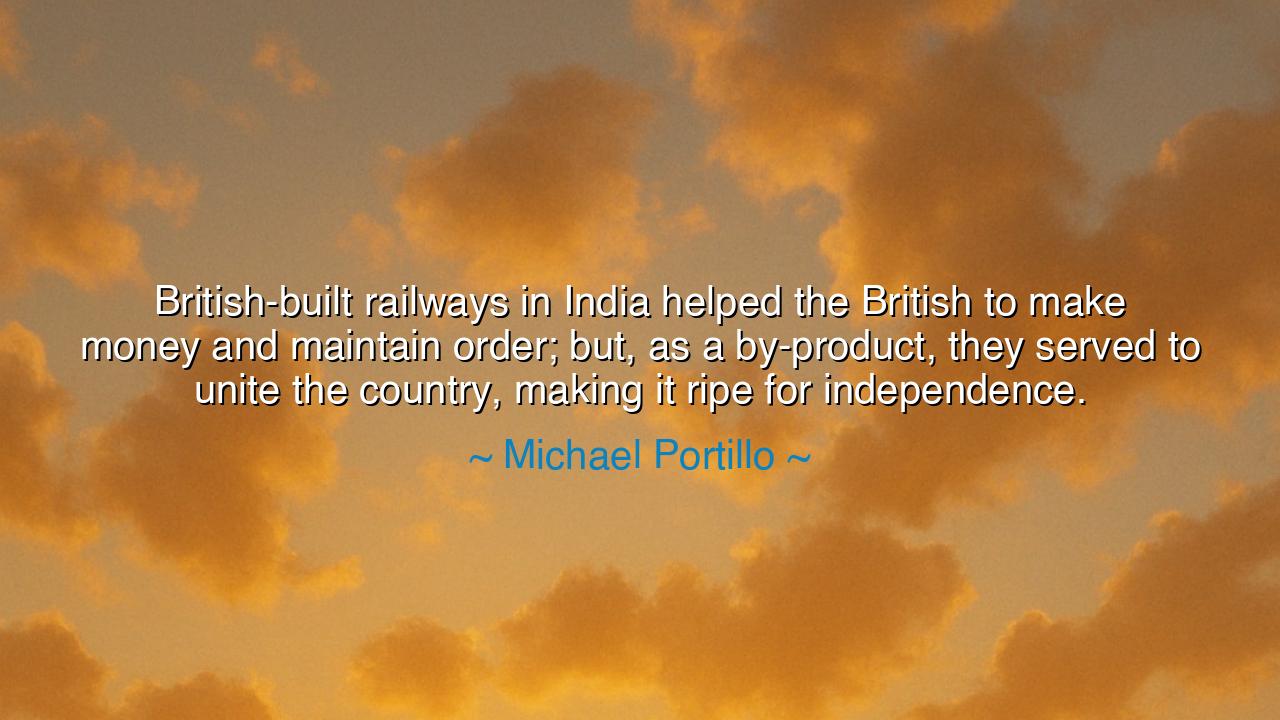
British-built railways in India helped the British to make money
British-built railways in India helped the British to make money and maintain order; but, as a by-product, they served to unite the country, making it ripe for independence.






Listen, O children of the future, to the words of Michael Portillo, who speaks of the profound and often paradoxical ways in which power and control shape the destinies of nations. "British-built railways in India helped the British to make money and maintain order; but, as a by-product, they served to unite the country, making it ripe for independence." These words are filled with wisdom, for they reveal a truth often unseen in the annals of history—the tools of oppression can, in the hands of those who would resist, become the very instruments of liberation.
The ancient world, too, was marked by the ironies of history. The Romans, who conquered vast lands through military might and engineering marvels, left behind roads and aqueducts that would serve not only their empire but the people they had subjugated. These roads, built to carry Roman legions and ensure the power of the empire, became the lifeblood of trade and communication for the provinces, binding them together in ways that would later support the rise of new empires. Just as the Romans built their roads to control, those roads also sowed the seeds of unity among the peoples of their conquered lands. In this way, even the tools of conquest can be turned to the service of unity and freedom.
India, under British colonial rule, experienced a similar paradox. The railways, which were built to serve the interests of the British—their ability to extract resources from the land and maintain order over a vast and diverse subcontinent—became, over time, a unifying force for the people of India. The iron rails that carried goods to distant shores and soldiers to the frontlines also connected communities that had been separated by language, culture, and geography. These railways did not merely bind the land together in the service of empire; they laid the foundation for a unified India, where ideas, movements, and people could travel swiftly and effectively across the nation.
Consider, O children, the rise of Indian nationalism in the late 19th and early 20th centuries. Leaders like Mahatma Gandhi, Jawaharlal Nehru, and Subhas Chandra Bose utilized the infrastructure left by the British to spread their message of freedom. The railways allowed them to travel and rally support for the cause of independence across the vast land. What had been a tool of oppression became a means of organizing and uniting the people. In this way, the very systems designed to control India served as the catalyst for the movement that would eventually lead to its freedom. The railways, though built by the British, became a symbol of the Indian people's ability to reclaim their land, to assert their will, and to move toward independence.
The lesson, O children, lies in the paradox that often defines the struggle for freedom. Even in the darkest moments of oppression, the forces that are meant to control and subjugate can sometimes become the very instruments that help to unite the oppressed and give them the means to rise. Technology, infrastructure, and even the systems of power that are designed to benefit the few can, in time, serve the many. But only if the people recognize their potential, if they see that their unity is not only a possibility, but a necessity. It is not the tools of oppression themselves that determine the outcome of history, but how the people choose to use them in their struggle for freedom.
So, O children of the future, take this wisdom to heart: in every struggle, look not just at the forces arrayed against you, but at the potential that lies within the very systems that seek to constrain you. Recognize that the path to freedom is often forged in the irony of history, where the very instruments of your oppression become the means of your liberation. The railways that the British built to tighten their grip on India became the same means by which the Indian people united, communicated, and organized their fight for independence. And so too, in your own lives, remember that the obstacles you face may one day be the very things that give you strength, provided you have the wisdom to see beyond their immediate use and understand their deeper purpose.
In your own journey, O children of the future, take courage in knowing that even in the face of seeming oppression, there is always a path to liberation—a path that may be found in the very tools that are used to suppress you. Know that the power to unite and the power to rise lies not just in the strength of your individual will, but in the strength of your collective effort. And when you come together, as those before you did, to shape your own destiny, you will find that even the most unlikely tools can be used to carve out the path to freedom.






AAdministratorAdministrator
Welcome, honored guests. Please leave a comment, we will respond soon